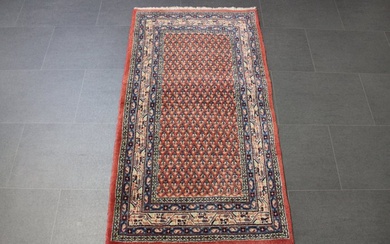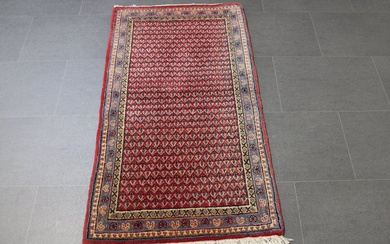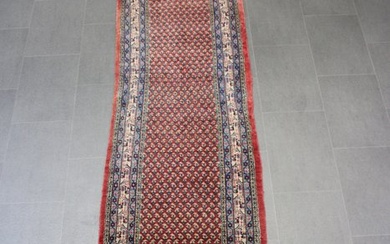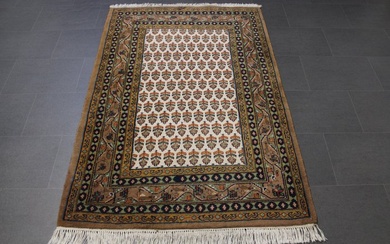Sarouk 310 X 246 Cm
Origin : Central PersiaSize: 310 X 246 cm (Approximately 122 X 96.9 inch)Age: From 3rd quarter of 20th centuryKnots 5 x 5 = 25 knots per sq cmCondition: Perfect, ready to useDescription of Design and History:Sarouk Rugs €œ The thickness of the luxurious pile allows Sarouk rugs to withstand the level of foot traffic that would be typical in hallways, common rooms and foyers. The style, quality and durability of Sarouk rugs have made them extremely popular with western consumers then and now. However, they weren „¢t always so popular. In the early 1900s, painted Sarouks that were over-dyed in vibrant hues of garnet and salmon-pink brought regional rugs to a new height of popularity. Although purists never appreciate these alterations, painted Sarouks are regional icons.Antique carpets produced in Sarouk feature classic curvilinear vinescrolls and opulent arabesques as well as local bouquet-filled designs that represent the diversity of regional carpet-weaving traditions. The carpets of Sarouk are traditionally made with blue weft threads. However, the surface designs and floriferous patterns incorporate a tremendous variety of pure and clear colors. The village of Saruk produces stunning medallion-and-corner rugs and exquisite allover Herati patterns, but the lush carpets that feature beautifully isolated bouquets and shrubs best represent the unique aesthetic of Sarouk. Whatever design they feature, Persian Sarouk carpets have an opulent and enduring aesthetic that will always be in demand.Sarouk rugs are among the most luxurious classically derived, room-sized Persian carpets. They were produced in the Arak region, not far from where Fereghans and Sultanabads were made. Some of the early examples were so closely related to Fereghans that they have been designated as Sarouk-Fereghans. While the latter tend to have medallion designs, Sarouk carpets from about 1900 onward were mostly produced in an allover format, with dense sprays or bouquets of flowers and vines arrayed across the carpet symmetrically, on a deep blue or burgundy ground. This latter type is known for its soft, velvety wool and fairly thick pile.Sarouk carpets derive their name from an obscure village in Persia, located twenty miles north of Arak (formerly Sultanabad). Over a short span of history, this village produced some of the most highly regarded Persian weavings of the late 19th to early 20th century. These rugs are easily recognizable despite their lack of consistent design elements. Most were room sized with central medallions and generally the wefts were blue. The field colors were cream, indigo or a pale red and floral motifs in the field showed multiply shades of orange, green and brown. The short velvet like pile is of excellent quality and wears well.All natural dyes are paramount for the carpet to have more than just decorative value. Beyond that, various dyers had varying levels of skill and invested different lengths of time in dyeing the yarns. The Å“quality of color €œits radiance and level of nuance within each color €œis centrally important. Certain rare colors such as Tyrian purple, saffron yellow, cochineal rose and greens add to the carpet „¢s value
Condition Report: The absence of a condition report does not imply that the lot is in perfect condition. Please carefully read our terms of sale, shipping pick up & payment information. We are happy and willing to answer questions about any of our lots as well as to send additional images. It is the responsibility of the bidder to pose any questions BEFORE bidding. Please email us for a shipping quote if needed. All sales are final.
View it on
Estimate
Time, Location
Auction House
Origin : Central PersiaSize: 310 X 246 cm (Approximately 122 X 96.9 inch)Age: From 3rd quarter of 20th centuryKnots 5 x 5 = 25 knots per sq cmCondition: Perfect, ready to useDescription of Design and History:Sarouk Rugs €œ The thickness of the luxurious pile allows Sarouk rugs to withstand the level of foot traffic that would be typical in hallways, common rooms and foyers. The style, quality and durability of Sarouk rugs have made them extremely popular with western consumers then and now. However, they weren „¢t always so popular. In the early 1900s, painted Sarouks that were over-dyed in vibrant hues of garnet and salmon-pink brought regional rugs to a new height of popularity. Although purists never appreciate these alterations, painted Sarouks are regional icons.Antique carpets produced in Sarouk feature classic curvilinear vinescrolls and opulent arabesques as well as local bouquet-filled designs that represent the diversity of regional carpet-weaving traditions. The carpets of Sarouk are traditionally made with blue weft threads. However, the surface designs and floriferous patterns incorporate a tremendous variety of pure and clear colors. The village of Saruk produces stunning medallion-and-corner rugs and exquisite allover Herati patterns, but the lush carpets that feature beautifully isolated bouquets and shrubs best represent the unique aesthetic of Sarouk. Whatever design they feature, Persian Sarouk carpets have an opulent and enduring aesthetic that will always be in demand.Sarouk rugs are among the most luxurious classically derived, room-sized Persian carpets. They were produced in the Arak region, not far from where Fereghans and Sultanabads were made. Some of the early examples were so closely related to Fereghans that they have been designated as Sarouk-Fereghans. While the latter tend to have medallion designs, Sarouk carpets from about 1900 onward were mostly produced in an allover format, with dense sprays or bouquets of flowers and vines arrayed across the carpet symmetrically, on a deep blue or burgundy ground. This latter type is known for its soft, velvety wool and fairly thick pile.Sarouk carpets derive their name from an obscure village in Persia, located twenty miles north of Arak (formerly Sultanabad). Over a short span of history, this village produced some of the most highly regarded Persian weavings of the late 19th to early 20th century. These rugs are easily recognizable despite their lack of consistent design elements. Most were room sized with central medallions and generally the wefts were blue. The field colors were cream, indigo or a pale red and floral motifs in the field showed multiply shades of orange, green and brown. The short velvet like pile is of excellent quality and wears well.All natural dyes are paramount for the carpet to have more than just decorative value. Beyond that, various dyers had varying levels of skill and invested different lengths of time in dyeing the yarns. The Å“quality of color €œits radiance and level of nuance within each color €œis centrally important. Certain rare colors such as Tyrian purple, saffron yellow, cochineal rose and greens add to the carpet „¢s value
Condition Report: The absence of a condition report does not imply that the lot is in perfect condition. Please carefully read our terms of sale, shipping pick up & payment information. We are happy and willing to answer questions about any of our lots as well as to send additional images. It is the responsibility of the bidder to pose any questions BEFORE bidding. Please email us for a shipping quote if needed. All sales are final.







